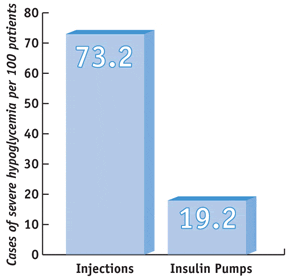 Diabetic management relies on proper adherence to dietary lifestyle changes, as well as, traditional diabetic therapy. Maintaining a healthy blood glucose level may not the easiest task, but in the end, can make all the difference in the daily life of a diabetes patient. One method of blood sugar control is insulin pump therapy. This technique requires an effective insulin pump and a knowledgeable and dedicated pump operator. To achieve the best possible results with this method of therapy, consistent glucose monitoring and precise attention to detail is a must.
Diabetic management relies on proper adherence to dietary lifestyle changes, as well as, traditional diabetic therapy. Maintaining a healthy blood glucose level may not the easiest task, but in the end, can make all the difference in the daily life of a diabetes patient. One method of blood sugar control is insulin pump therapy. This technique requires an effective insulin pump and a knowledgeable and dedicated pump operator. To achieve the best possible results with this method of therapy, consistent glucose monitoring and precise attention to detail is a must.
Adjusting Basal and Bolus Rates
As you begin insulin-pump therapy, your physician will supply you with a target range basal and bolus rate. Your blood glucose levels will change according to stress, eating habits, and life progression in general. All forms of stress can change sugar levels, both positive and negative. While these particular stressors only last for a temporary period of time, they can cause fluctuation, and it is up to you as a patient to check you’re basal and bolus rates to assure that they are correct.
The basal rates should be always checked first. When deciding when to check these rates, choose a day when both your activities and eating habits are somewhat normal. Over the period of one day, the basal flow of insulin contributes to almost half of an individual’s insulin requirement. It is best to start with overnight basal rates. Your evening dose of insulin should be taken no later than six p.m. when determining overnight rates. To start your monitoring, check your blood sugar level approximately four hours after your latest dose. The test can begin if your blood sugar level is in the normal range. It must be stressed that your overnight basal level test cannot be administered until your levels are in the target range. A high reading means that another dose must be taken. If your blood sugar level is on the low end of the spectrum, you must eat to increase it. Once you have reached your target rate, the test administration can begin. First, divide the amount of night hours into testing sections or “windows.” This portion should extend for no more than four hours. A suggested time frame is once in the evening, another at bedtime, and then a last testing during the night. A suitable blood glucose rate should not extend 30 points in range. A fluctuation of blood sugar levels between testing windows suggests that your basal rate should be altered. You should plan to do testing on a few different occasions to be sure that your results are correct.
If you find that your basal rates are in the normal range, but you are still experiencing a fluctuation in blood sugar levels, your bolus insulin dose must be checked. These fluctuations can occur for a number of reasons. A change in weight or size can produce an effect, in addition to insulin resistance. You may also want to consider if you’re eating habits have changed. An increase in portion size may be the cause of glucose level changes. To achieve suitable glucose levels, it is crucial that your daily insulin to carbohydrate ratio is correct. Remember, however, that this ratio may change at different parts of the day. Testing of the bolus dose requires that you check your blood sugar level before a meal. Then administer an insulin dose and eat in a normal manner. The test should be repeated about two hours after you meal. Again, if you find a variation of more than 30 points between the two blood glucose readings, your bolus dose must be adjusted.